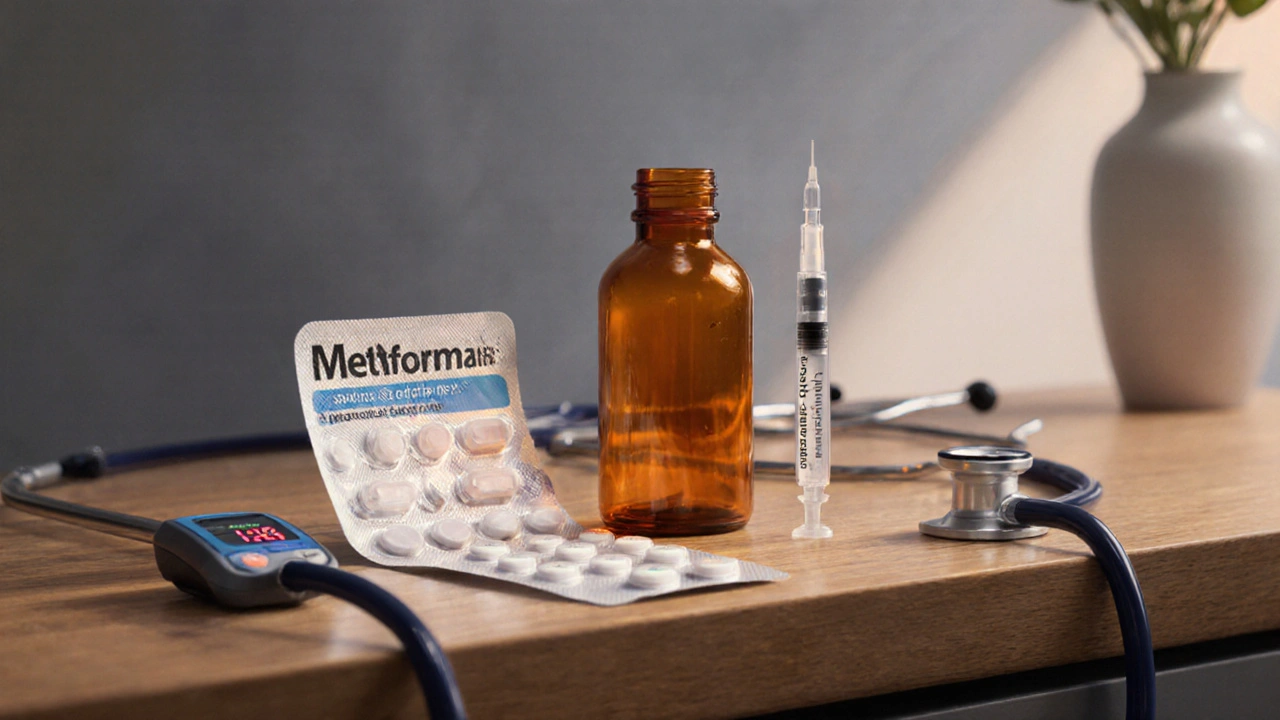Actos vs Alternatives Comparison Tool
Use this tool to compare Actos (pioglitazone) with other diabetes medications based on your specific health needs and preferences.
Recommended Medications
About Actos (Pioglitazone)
Actos is a thiazolidinedione that improves insulin sensitivity by activating PPAR-γ receptors. It's effective for lowering blood sugar but has potential side effects including weight gain and fluid retention.
- Dosage: Starts at 15mg daily, may increase to 30mg
- Side Effects: Weight gain, fluid retention, increased fracture risk
- Best For: Patients needing improved insulin sensitivity
Quick Takeaways
- Actos (pioglitazone) lowers blood sugar by improving insulin sensitivity but can cause weight gain and fluid retention.
- Metformin remains the first‑line, low‑cost option with a strong safety record.
- SGLT2 inhibitors (e.g., empagliflozin) add cardiovascular protection but may raise the risk of urinary infections.
- GLP‑1 agonists (e.g., liraglutide) promote weight loss and heart benefits but require injections.
- Choosing the right drug depends on kidney function, heart health, cost, and personal preferences.
What is Actos?
Actos is a brand name for pioglitazone, an oral thiazolidinedione that improves insulin sensitivity in people with type2 diabetes. It works by activating the PPAR‑γ receptor, which helps fat cells store glucose more efficiently and reduces insulin resistance.
Typical dosage starts at 15mg once daily, possibly titrating to 30mg. The drug is taken with or without food and is cleared mainly by the liver.

Why Look at Alternatives?
While Actos can be effective, it isn’t a one‑size‑fits‑all solution. Common downsides include:
- Weight gain (about 2‑4kg on average).
- Fluid retention, which can worsen heart failure.
- Increased risk of bone fractures in women.
- Potential interaction with certain antibiotics and antifungals.
Patients with a history of heart failure, osteoporosis, or those who simply dislike weight gain often ask for different options.
Top Alternatives to Actos
Below are the most widely prescribed alternatives, each introduced with a short definition and key attributes.
Metformin
Metformin is a biguanide that decreases hepatic glucose production and improves peripheral insulin uptake. First‑line for most adults because it’s cheap ( Empagliflozin belongs to the SGLT2‑inhibitor class; it blocks glucose reabsorption in the kidney, causing sugar to leave the body via urine. Adds cardiovascular and renal protection, but can cause genital yeast infections. Liraglutide is a GLP‑1 receptor agonist administered by daily subcutaneous injection; it stimulates insulin release, suppresses appetite, and slows gastric emptying. Promotes weight loss and lowers heart‑attack risk, though the injection and cost ( Sitagliptin is a DPP‑4 inhibitor that raises endogenous GLP‑1 levels, enhancing glucose‑dependent insulin secretion. Well‑tolerated, minimal hypoglycemia, but modest efficacy and higher price than metformin. Rosiglitazone is another thiazolidinedione similar to pioglitazone but with a stronger association to cardiovascular events. Used rarely nowadays, mainly when other options fail. Lifestyle modification includes diet changes, regular exercise, and weight management; it directly improves insulin sensitivity without medication side effects. Requires commitment and professional guidance. Think of the decision as a simple checklist. Match your personal health profile against the following criteria: Bring this list to your doctor or pharmacist. Most clinicians will start with metformin, add a second agent based on the above factors, and only consider pioglitazone if they need an insulin‑sensitizer without risking hypoglycemia. Yes, the combination is common. Metformin tackles hepatic glucose output while Actos improves peripheral insulin sensitivity, giving an additive effect on HbA1c. PPAR‑γ activation promotes sodium reabsorption in the kidneys, leading to mild edema. Patients with existing heart failure should avoid it. Generally, yes. Liraglutide can lead to 5‑7kg loss over a year, while Actos typically adds weight. The trade‑off is the need for daily injections and higher cost. Monitor for genital yeast infections, stay well‑hydrated, and avoid using it if you have frequent urinary tract infections. Also, discuss with your doctor if you’re on diuretics. If your blood sugar is well‑controlled with diet, exercise, and maybe metformin, you can discontinue Actos under medical supervision. Sudden stop without a replacement can raise glucose quickly.Empagliflozin
Liraglutide
Sitagliptin
Rosiglitazone
Lifestyle Modification
Side‑by‑Side Comparison
Drug / Option
Class
Mechanism
Typical Dose
Major Benefits
Common Side Effects
Approx. Monthly Cost (AU$)
Actos (Pioglitazone)
Thiazolidinedione
PPAR‑γ activation → ↑ insulin sensitivity
15‑30mg PO daily
Good HbA1c reduction, low hypoglycemia risk
Weight gain, edema, bone fracture (women)
AU$30‑45
Metformin
Biguanide
↓ hepatic gluconeogenesis, ↑ peripheral uptake
500‑2000mg PO daily (split)
Cost‑effective, cardiovascular benefit
GI upset, rare lactic acidosis
AU$5‑10
Empagliflozin
SGLT2‑inhibitor
Inhibits renal glucose reabsorption
10‑25mg PO daily
Heart‑failure & renal protection
UTI, genital yeast infection, dehydration
AU$80‑120
Liraglutide
GLP‑1 agonist
Stimulates insulin, reduces appetite
0.6‑1.8mg SC daily
Weight loss, ↓ MACE risk
Nausea, vomiting, pancreatitis (rare)
AU$200‑300
Sitagliptin
DPP‑4 inhibitor
Increases endogenous GLP‑1
100mg PO daily
Well‑tolerated, neutral weight effect
Headache, nasopharyngitis
AU$90‑130
Rosiglitazone
Thiazolidinedione
PPAR‑γ activation (similar to pioglitazone)
4‑8mg PO daily
Strong HbA1c lowering
Fluid retention, ↑ myocardial infarction risk
AU$40‑60
Lifestyle Modification
Non‑pharmacologic
Calorie deficit, ↑ physical activity
Varies (diet, exercise plan)
Can reverse pre‑diabetes, no drug side effects
Requires discipline, slower glucose drop
AU$0‑200 (coach fees)

How to Choose the Right Option
Practical Tips for Switching from Actos
Frequently Asked Questions
Can I use Actos and Metformin together?
Why does pioglitazone cause fluid retention?
Is a GLP‑1 agonist better than Actos for weight loss?
What should I watch for when switching to an SGLT2 inhibitor?
Can I stop Actos completely without another drug?


Vera REA
October 10, 2025 AT 15:58Actos certainly has its place, especially in communities where insulin resistance runs high due to dietary patterns. The drug’s ability to sensitize peripheral tissues can be a game‑changer for patients who struggle with metformin alone. However, clinicians should be mindful of the modest weight gain that often accompanies therapy, as it may offset some of the metabolic gains. Fluid retention is another nuance that can exacerbate heart failure in susceptible individuals. In practice, I’ve seen better outcomes when Actos is paired with lifestyle counseling that respects cultural food preferences.
John Moore
October 19, 2025 AT 02:38Honestly, if heart health is your top concern, SGLT2 inhibitors beat Actos hands down. They drop blood pressure, shave off pounds, and even lower cardiovascular mortality in large trials. While the cost can be higher, many insurers now cover them for high‑risk patients. I’ve switched a few friends from pioglitazone to empagliflozin and they report less swelling and more energy. Bottom line: weigh the cardio benefits against the extra expense.
Adam Craddock
October 27, 2025 AT 13:18From a mechanistic standpoint, pioglitazone belongs to the thiazolidinedione class, which exerts its glucose‑lowering effect primarily through activation of the peroxisome proliferator‑activated receptor gamma (PPAR‑γ) nuclear receptor. Upon ligand binding, PPAR‑γ heterodimerizes with the retinoid X receptor and modulates transcription of genes involved in adipocyte differentiation, lipid uptake, and insulin signaling pathways. This transcriptional reprogramming enhances peripheral glucose utilization and decreases hepatic gluconeogenesis, thereby improving overall glycemic control. The pharmacokinetic profile of pioglitazone is characterized by high oral bioavailability, extensive hepatic metabolism via CYP2C8 and CYP3A4, and an elimination half‑life of approximately 3–7 hours for the parent compound, extending to 24 hours for its active metabolites. Dose titration typically commences at 15 mg once daily, with escalation to 30–45 mg contingent upon therapeutic response and tolerability. Adverse effect monitoring should focus on weight trajectories, peripheral edema, and signs of cardiac decompensation, especially in patients with pre‑existing heart failure. Bone density assessments are advisable for post‑menopausal women, given the documented increase in fracture risk associated with long‑term thiazolidinedione exposure. Renal function remains relatively preserved, allowing use in mild to moderate renal impairment, yet caution is warranted in severe disease. Comparative effectiveness studies have demonstrated that while pioglitazone may achieve modestly greater HbA1c reductions than metformin in certain cohorts, the overall risk‑benefit ratio is heavily influenced by individual comorbidities. Economic analyses suggest that the drug’s lower acquisition cost can be offset by expenses related to managing edema and potential hospitalizations for heart failure. In clinical decision‑making, the integration of patient preferences, such as aversion to weight gain, is essential. Moreover, the drug–drug interaction profile includes potentiation of hypoglycemia when combined with sulfonylureas or insulin, necessitating dose adjustments. Ultimately, pioglitazone remains a valuable therapeutic option for patients whose primary therapeutic goal is to enhance insulin sensitivity, provided that vigilant monitoring protocols are instituted.
Kimberly Dierkhising
November 4, 2025 AT 23:58When you dive into the PPAR‑γ agonism cascade, you’ll notice that pioglitazone orchestrates a pleiotropic transcriptional milieu, upregulating adiponectin and downregulating resistin, which collectively fine‑tune the insulin‑signaling nexus. The lipogenic shift promotes subcutaneous fat storage, sparing ectopic deposition, but at the expense of incremental adiposity and plasma volume expansion. Clinicians often grapple with the rheologic ramifications of increased interstitial fluid, particularly in the context of NYHA Class II‑III heart failure. From a pharmacodynamic perspective, the drug's high affinity for the receptor (Kd ≈ 10 nM) translates into a sustained downstream effect despite its relatively short plasma half‑life. In practice, the therapeutic window is broad, yet the safety margin narrows once comorbid renal or hepatic insufficiency enters the equation.
Rich Martin
November 13, 2025 AT 10:38What you’re really getting at is the classic risk‑benefit calculus that every clinician must perform. On one hand, you have a molecule that reprograms cellular metabolism in a way that could, theoretically, stave off the progressive β‑cell failure we see in type 2 diabetes. On the other, you’re inviting fluid overload, which is nothing to scoff at in patients with marginal cardiac reserve. It’s a philosophical question as much as a medical one: do we prioritize a modest HbA1c drop or safeguard against heart failure exacerbations? In my experience, a shared decision‑making framework does the trick-lay out the data, acknowledge the trade‑offs, and let the patient’s lifestyle preferences steer the ship.
Buddy Sloan
November 21, 2025 AT 21:18I totally get the worry about weight gain 😕, but many folks report that the swelling actually goes down once they tweak their diet and add a bit of exercise. If you’re already on a loop diuretic, the fluid retention isn’t as scary. Just keep an eye on any sudden swelling and talk to your doc! 😊
Brooke Bevins
November 30, 2025 AT 07:58Enough with the sugar‑coating-pioglitazone can literally flood you with fluid and set you up for a heart failure flare 🚨. If you’re not ready to babysit your weight and your heart, ditch it ASAP and look at SGLT2 or GLP‑1 options. No excuses, just results. 💪
Jeremy Wessel
December 8, 2025 AT 18:38Metformin stays cheapest first‑line option.